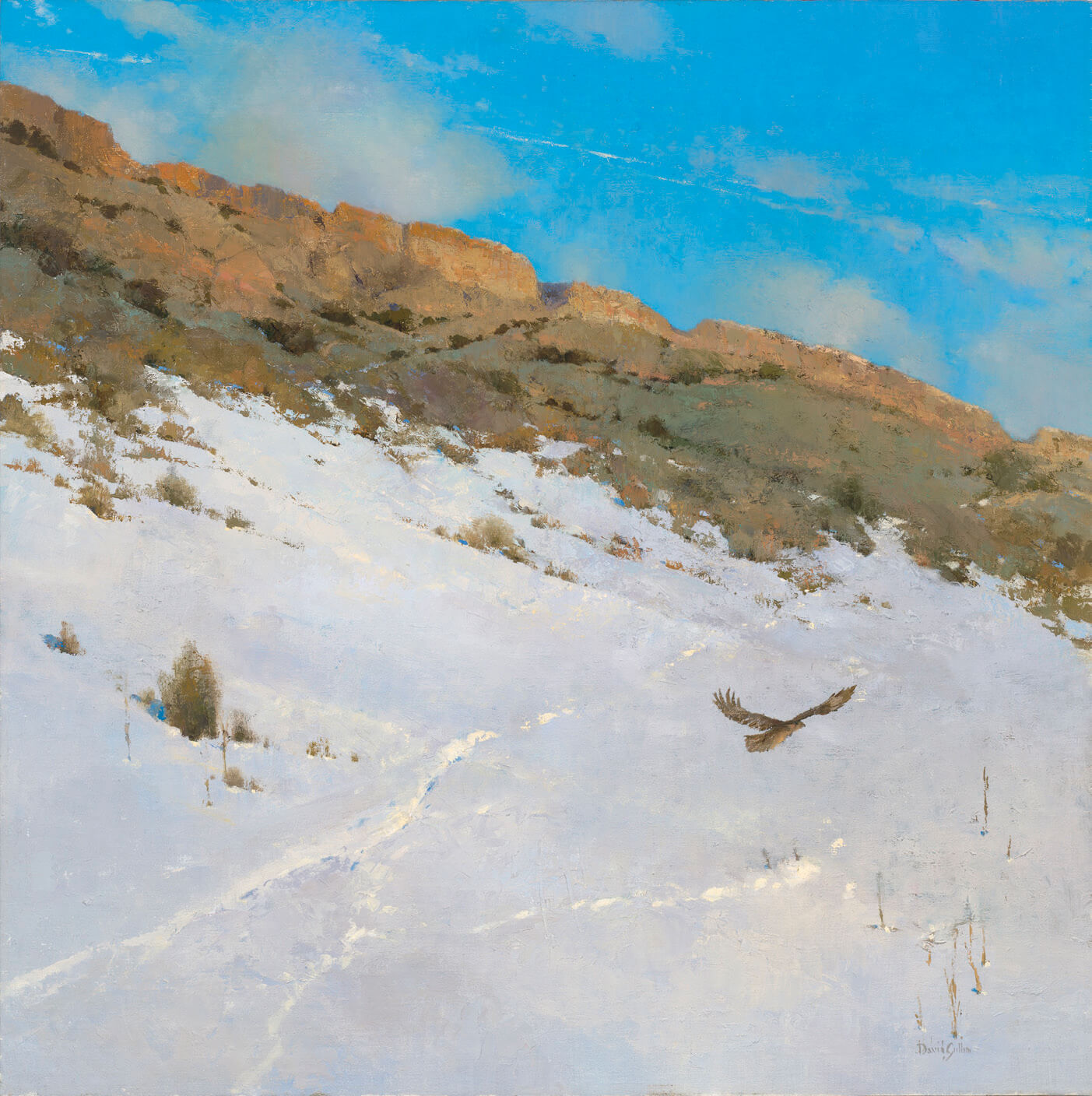
15 Mar Collector’s Notebook: Behind the Veil
Art is a team sport. Perhaps this sounds counterintuitive, but in reality, the cliched vision of the tortured artist working alone in a bleak, drafty studio is a bit more Hollywood than true life. Yes, the seeds of creativity need quiet space to take root, but equally important is time spent sharing ideas, commiserating, collaborating, and exchanging news of the world. And among many artists’ supporting cast of creatives is the curator, whose job is frequently misunderstood and often overlooked.
The word “curate” comes from the Latin word curatus, which means “to take care of.” According to a 2020 article in The New York Times, historically, in museums and archives, “curators polished finishes, inspected canvases, and layered archival tissue. The idea of curators as creative agents in their own right, and master of the kind of sociopolitical commentary that underpins many of today’s exhibitions, is relatively new,” writes author and curator Lou Stoppard.

David Griffin, Thunderstruck | Oil | 40 x 30 inches
When the relationship between artist and curator is working well, each person is clear about their role. Texas landscape artist David Griffin, who started his career as an illustrator and transitioned into fine art in the 1990s, learned just how complex relationships with curators could be. He discusses the curator-artist relationship, providing examples of when it’s healthy and when it can be downright harmful.
It started when a local gallerist stepped into Griffin’s illustration studio and noticed a few paintings the artist had done after a trip to Europe. “He took three or four of those paintings and sold them right away,” Griffin says. At the time, the artist was supporting his family with his illustration business and only dreamed of making a living painting what he wanted to paint. “That helped me make up my mind to switch from illustration to fine art,” Griffin says. “My break was pretty clean. One day I was doing illustration; the next I was painting.”
Joining a gallery gave Griffin the nudge he needed to get off the hamster wheel of creating assigned illustrations under tight deadlines, a job he equates to factory work. “An art director would just send me a script, and I’d have to turn it out,” he says. “I got tired of being somebody’s hands.”
At first, his leap into the Western art market felt like freedom. And even though he only had one gallery representing his work, it sold well. But then the gallerist started stepping in, requesting that he paint certain subjects and compositions. “I remember going to lunch, and that dealer would set a napkin on the table and draw out what I should paint,” Griffin says. “I never had to ask him what he wanted me to do. Basically, it was: ‘Here’s the script, and I’m going to give you the outline, David, and I’m going to tell you what to do.’ I was a private — showing up, saluting, doing the paintings.”
Then suddenly, his only art dealer called and told him to pick up his work, that he needed to do something else.
Looking back, Griffin acknowledges that each crazy fork in the road led to a better place, whether he knew it at the time or not. This was one of the scarier lessons to learn, but soon he landed in a new gallery where the owner wasn’t as explicit about directing his work. He did, however, let Griffin know which paintings and subjects he wanted. And he warned Griffin not to surprise him or his clients with anything outside the box because he didn’t want to “spend a lot of time explaining what you’re doing.”
Because of the influence the gallerists imposed as “curators,” Griffin wasn’t truly painting for himself; he had simply swapped one art director for another. Those days are behind him now, thanks to gallerists who told him that it’s not their job to paint — that’s his job. Their job is to create a space for him to show his work.
Griffin is hardly the first artist to run up against curators and dealers wanting too much control. In fact, it can be surprisingly prevalent as a condition of the art market and desire to sell more work. Denver artist Quang Ho began a collaborative venture with Gallery 1261 to encourage exploration by inviting artists to show their most experimental work. “My concept was to encourage artists to follow their intuition and not focus on what sells,” Ho says. “I wanted them to follow their muse and not be restrained by the market.”
Every artist Ho invited to the gallery embraced the concept. And Ho rose to the occasion as a curator and “catalyst” for helping along new ideas. Interestingly, though, he soon discovered that giving artists that kind of freedom is a tall order — primarily, he explained, because artists run up against two creativity-crushing limitations: time and money. “It takes an extra-special artist to follow through,” Ho says. “I see a lot of fear. And I think it’s really hard to be original all the time. Even with all the freedom in the world, if you don’t have a clear vision, it’s hard to know where to go.”
Griffin agrees. “Not having anyone directing me, telling me what to do — believe it or not, that’s hard,” he says. “I look back on that now, and it was kind of a crutch and one of those things that was holding me back. I was in the marketplace and selling but without complete freedom. To be honest with you, when you’re given the freedom to do your own thing, it exposes your weaknesses. I could draw, I could paint, I knew color, but now I had to come up with my own ideas and had to ask myself if I was up for the task. So, it did expose weaknesses, but they needed to be exposed. I needed to look at my weaknesses and my failures if I was going to be an artist.”
Therein lies the curator’s most difficult chore: to encourage without suggesting and to support without crossing the line into art directing. “I feel like the call of an artist is to follow your intuition,” Ho says. “You shouldn’t be held back by those limitations — time and money — because they kill the artistic spirit.”
But there’s also no denying that money is required for continued creative practice. What if you scare off your collectors, who know you for one thing and wonder what you’re suddenly doing? “I’m too dumb to ever worry about scaring off collectors,” Ho says, laughing. “My last show, I had 45 different paintings, and it looked like 10 different artists did them. I think people really understand my need to explore.”
That need to explore is at the core of artistic expression. As Griffin puts it, a good curator can create a safe space that allows an artist to express his voice. “I do think there is something to being able to say, ‘This is my own voice,’ metaphorically, and to have people respond. But it is scary because you just don’t know. We all want people to like us. The extension of that is: if people like my work, they like me. That’s a bad way to put a value on things. But it’s risk and reward. The reward is bigger.”
A Curator’s Mindset
After nearly 30 years of overseeing the Coors Western Art Exhibit & Sale, curator and “Collector’s Notebook” columnist Rose Fredrick has developed a list to refer to when planning exhibitions or adding to a collection.
- Avoid Imposing: An artist is not an extension of you. Never tell an artist what to paint, photograph, sculpt, or make. They’re the ones taking all the risks in this business, so give them the respect and freedom to do their job, even when creating commissioned work.
- Continuity: Decide on a theme for the collection. If you are curating an exhibit, express the theme clearly to the artists and your audience.
- Embrace Surprise: Art that is wildly different from anything else you collect but holds true to your theme should be included. Once introduced, it will highlight the other pieces in the collection.
- Broaden your Horizons: If you wake up thinking of an unusual piece, it’s a good sign to consider purchasing it. And art that challenges your identity is important to include; it helps expand your worldview and understanding of yourself.
- Determine the Motivation: Learn everything you can about each artist you wish to collect. In particular, listen to their “why” or the reason they wake up and head to the studio every day.
- Artist for Hire: If you have a strong vision for a particular artwork for your collection, a commission might be a good route. But let the artist create work that comes from their own volition. And, if you really have a strong idea, consider taking classes from a local art school, atelier, or artist you admire — you may have a hidden talent you’ve kept buried for too long.






No Comments